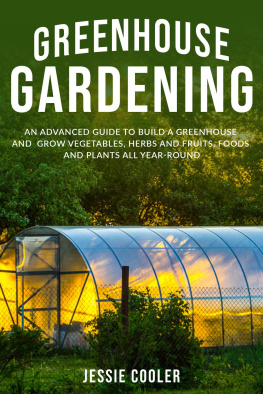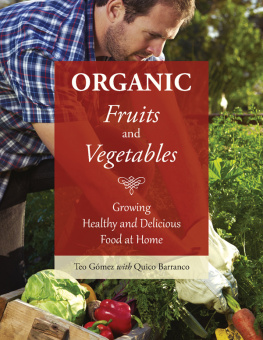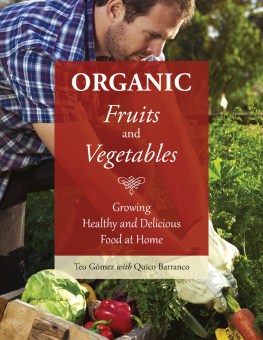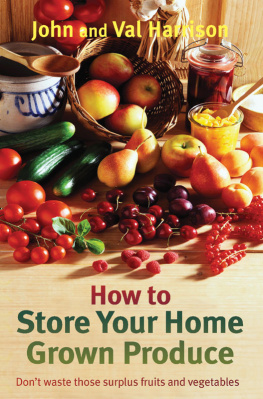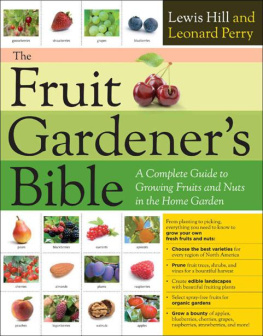Contents
About the Book
In Forgotten Fruits, Christopher Stocks tells the fascinating often rather bizarre stories behind Britains rich heritage of fruit and vegetables. Take Newton Wonder apples, for instance, first discovered around 1870 allegedly growing in the thatch of a Derbyshire pub. Or the humble gooseberry which, among other things, helped Charles Darwin to arrive at his theory of evolution. Not to mention the ubiquitous tomato, introduced to Britain from South America in the sixteenth century but regarded as highly poisonous for hearly 200 years.
This is a wonderful piece of social and natural history that will appeal to every gardener and food aficionado.
About the Author
Christopher Stocks is a writer and journalist who has worked for, among others, Harpers & Queen, ES Magazine, Arena and Wallpaper, reporting on everything from Uruguayan beach resorts to an underground submarine base off the coast of Sweden. More recently he wrote a weekly gardening column for the Independent On Sunday, and he is a regular contributor to Gardens Illustrated. He collects unusual perfumes and old Shell Guides, won a 2007 Bridport Prize for his poetry, and shares a birthday with Donny Osmond and Hermione Gingold. Forgotten Fruits is his first book.
To Roy and my parents
Introduction
SANDWICHED BETWEEN HEATHROW airport, the Queen Mother reservoir and the M25, Colnbrook is one of those unexpected scraps of pre-twentieth-century London that, against all the odds, has survived into the twenty-first. Once an important staging post on the road to Bath, it was bypassed in the late 1920s, with the result that the narrow village street still runs, much as it must have done in quieter days, past brick-built cottages and the ancient, half-timbered Ostrich Inn, where in medieval times (so the story goes) the landlord and his wife murdered around sixty of their guests by pitching them, one after another, into a barrel of boiling beer.
Yet, the most interesting building in Colnbrook is not the Ostrich Inn, but a deeply uninspiring block of modern low-rise flats a little further east along whats now called the Old Bath Road. It might not be much to look at, but then whats interesting about The Lawns, as the block is known, is not its architectural distinction (or lack of it) but its incongruously bucolic name. It is called The Lawns because it stands near the site of a nineteenth-century villa of the same name. And as an address, The Lawns, Colnbrook, occupies a surprisingly important place in British history or rather it would if we took the story of our food as seriously as we take the story of our kings and queens and country houses.
In the early nineteenth century Colnbrook was still a small country village that combined rustic charm with easy access to Windsor and the capital. It was just the kind of place where a comfortably-off Londoner might choose to spend his twilight years, and in the early 1820s a retired brewer from Bermondsey took a lease on The Lawns (or Lawns Cottage, as it was sometimes known) along with two acres of orchards and gardens. Around 1825 he planted some seeds of a Ribston Pippin apple, and a few years later the seedlings that came up bore fruit for the first time. Like most apples grown from seed they were quite different from their parent, and one in particular stood out for its wonderful flavour. In 1836 he gave some grafts of the young tree to one of his neighbours, a nurseryman called David Small, who lived at Nursery Cottage on Colnbrook High Street. Small and his son James started selling this new variety in 1840, and before long other nurseries took it on and its fame began to spread. By the end of the nineteenth century it had become one of the most popular apples in Britain.
The name of the retired brewer was Richard Cox, and his apple became known as Coxs Orange Pippin. Today it is the most widely grown apple in the world, yet every one of those millions of trees can trace its ancestry directly back to that single seedling, planted by Richard Cox at The Lawns, Colnbrook, in 1825.
Mr Coxs villa and gardens have long since disappeared, replaced by modern housing and a car park. No one thought to preserve them, and the original Orange Pippin tree is said to have blown down in 1911 during a gale. Other than its name, The Lawns today bears no sign of its place in culinary history, which is a shame, though Nursery Cottage still stands. But Colnbrook has not forgotten Richard Cox entirely. Not far away, in Albany Park, a small community orchard was planted in 1992, with Coxs Orange Pippin trees and three metal benches in the shapes C, O and X a typically imaginative contribution from the charity Common Ground, which works with local communities to enhance the spirit of our everyday places.
Coxs Orange Pippin may be the most successful apple of all time, but for all its fame surprisingly few of us are familiar with its story. And it is only one among hundreds of outstanding varieties of fruit and vegetables of which this country can boast. Many of them have histories at least as long and equally interesting, yet we hardly ever see them for sale in the shops, on restaurant menus or in cookery books. Some, which were once as celebrated as Coxs Orange Pippin, have since been almost entirely forgotten or altogether lost. Others are still relatively easy to find, at least if you know where to look.
This book is an attempt to rescue the best of the survivors from undeserved obscurity. Some, such as the May Duke cherry or the Martock bean, may well be hundreds of years old. Others have close connections to a particular region, village or town; sometimes even to a specific house, like the Pitmaston Duchess pear. There are onions named after islands, redcurrants named after castles, even a parsnip named after a popular song. Many varieties commemorate individual people: brilliant professional gardeners and gifted amateurs, as well as ordinary folk such as George Crook, who in 1833 stumbled across the Yellow Egg plum growing wild in a Worcestershire wood who just happened to be in the right place at the right time. A number of varieties deserve to be grown for their names alone: who could resist a gooseberry called Hero of the Nile, a plum called the Warwickshire Drooper or a turnip that glories in the name of Orange Jelly?
The damp, temperate British climate allows us to grow a wider range of fruit and vegetables than virtually anywhere else on earth, and the history of their introduction, adoption and improvement has mirrored the transformations in British society from the Roman conquest right through to the present day. Fashions in food have changed just as radically over the centuries as fashions in clothing, but the former tend to be less well known, perhaps because food fashions change so much more slowly. Our forebears would have thought us crazy to eat tomatoes, which were considered fit only for decoration; mind you, they would have thought us mad to eat just about anything raw, including apples, pears, plums and celery, the majority of which, until the mid-eighteenth century, would have gone straight into the cooking pot. Brussels sprouts were once regarded as fashionable upper-class delicacies; cucumbers were believed to be fatal in any quantity; and potatoes were treated with grave suspicion though at least they were never actually illegal in this country, as they were in France between 1748 and 1772.
International upheavals had unforeseen consequences too. Without the Spanish Inquisition our carrots might never have been orange, while the French Revolution was at least partly responsible for the triumph of British strawberries in the nineteenth century. Even the humblest root crops have their claims to fame: beetroot, for example, is in part responsible for the abolition of slavery, while swedes helped lay the foundations for the Industrial Revolution; carrots did their bit towards winning the Second World War in their guise as an undercover secret weapon, and there would not be so many Irish-Americans in the United States if it wasnt for a potato.
Next page

